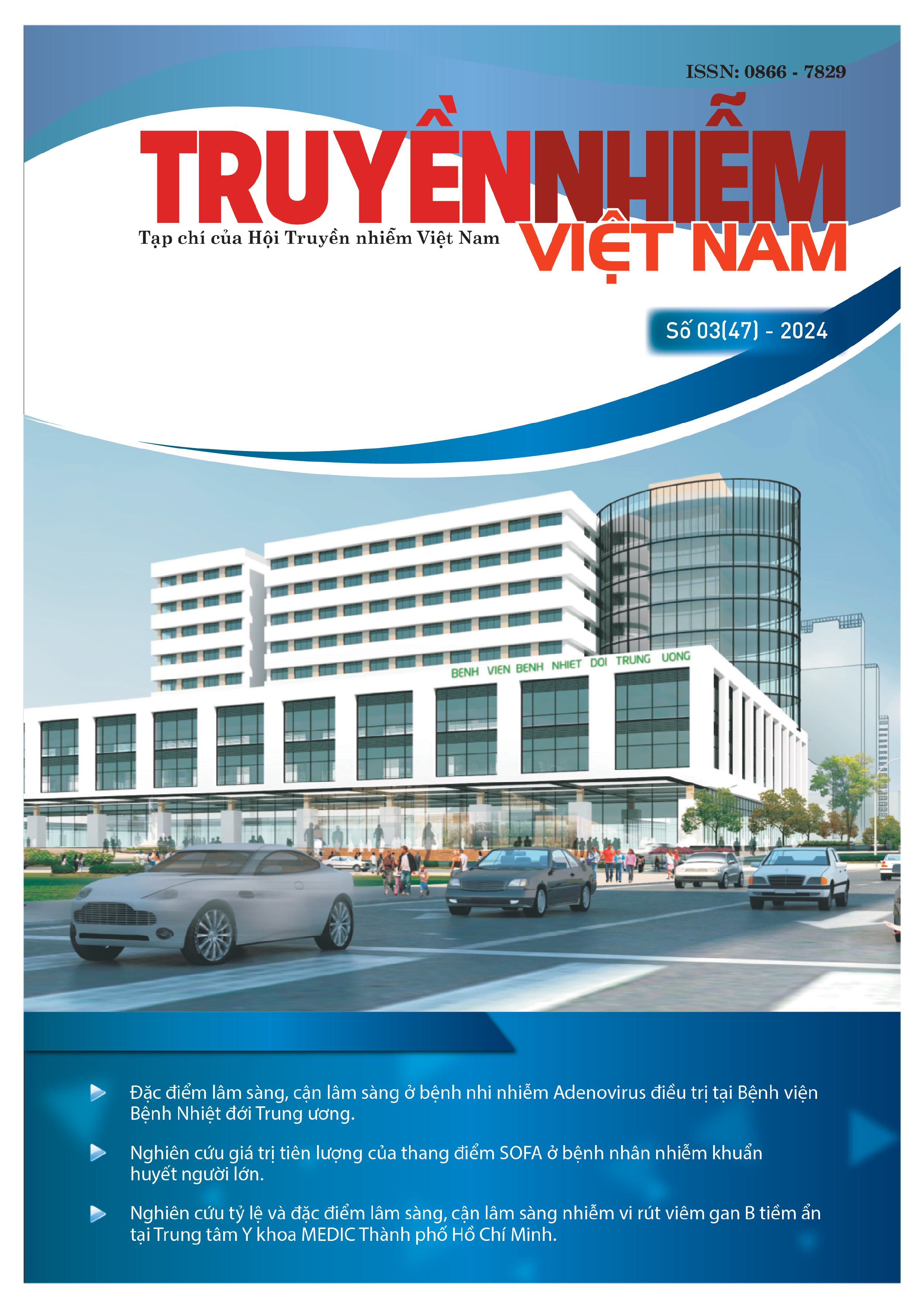CLINICAL AND PARACLINICAL CHARACTERISTICS AND RESULTS OF TREATMENT OF SEVERE COMMUNITY ACQUIRED PNEUMONIA AT THE INTENSIVE CARE UNIT IN NGHE AN FRIENDSHIP GENERAL HOPSPITAL
Main Article Content
Abstract
Objectives: Evaluate clinical, sublinical characteristics and results of treatment of severe communityacquired pneumonia at the Department of Intensive Care Unit - Nghe An Friendship General Hospital.
Subjects: The study describes 64 patients diagnosed and treated for severe community-acquired pneumonia from 10/2012 to 9/2023.
Subjects and methods: Cross-sectional descriptive study.
Results: Average age 71.1 ± 16.8; lowest 23 years old, highest 96 years old; men 65.6%; female 34.4%. Clinical: History of smoking 46.8%. Consciousness disorders accounted for 10.9%; temperature ≥ 37,5
độ C 48.5%; Heart rate ≥ 125 beats/minute 21.8%; respiratory rate ≥ 30 times/minute 31.2%; systolic blood pressure < 90 mmHg 23.4%; SpO2 < 90% 43.7%; Moist rales, crackles 89.1%. Paraclinical: WBC > 10 G/L 66.4%; WBC < 4 G/L 9.3%; PCT > 10 ng/mL 30.0%, PCT from 2 - 10 ng/mL 20.0%, 0.5 ng/mL ≤ PCT < 2 ng/mL10%. Sputum culture was positive in 35.9%; Haemophilus Influenza 56.5%; Klebsiella Pneumonia 21.7%. Treatment: Breathe oxygen 39.1%; Non-invasive ventilation 29.7%; invasive mechanical ventilation 31.2%; combination of 2 antibiotics 65.6%. Results treatment: 68.7% cured, less than 7.8% referred to hospital, 23.5% returned home.
Conclusions: Clinically, there is often fever, rapid pulse, low blood pressure, and moist crackles and crackles on auscultation.Paraclinically, there is increased white blood cells, increased procalcitonin, X-rays show typical lesions of bronchopneumonia, and common bacteria are Haemophilus Influenza and Klebsiella Pneumonia. Treatment is often a combination of two antibiotics, the cure rate is high but the death rate is still high, accounting for 23.5%.
Article Details
Keywords
Severe community-acquired pneumonia, Intensive Care Unit, Nghe An Friendship General Hospital
References
2. Phua J., Dean N.C., Guo Q., et al. (2016). Severe community-acquired pneumonia: timely management measures in the first 24 hours. Crit Care Lond Engl, 20(1), 237.
3. Mandell L.A., Wunderink R.G., Anzueto A., et al. (2007). Infectious Diseases Society of America/American Thoracic Society consensus guidelines on the management of community-acquired pneumonia in adults. Clin Infect Dis Off Publ Infect Dis Soc Am, 44 Suppl 2(Suppl 2), S27-72.
4. Nguyễn Tường Sơn (2020). Quyết định 4815/QĐ-BYT 2020 tài liệu Hướng dẫn chẩn đoán viêm phổi mắc phải ở người lớn. Bộ Y tế.
5. Kim M.-A., Park J.S., Lee C.W., et al. (2019). Pneumonia severity index in viral community acquired pneumonia in adults. PloS One, 14(3), e0210102.
6. Hoàng Thị Thùy (2020). Nghiên cứu đặc điểm lâm sàng cận lâm sàng và yếu tố nguy cơ của viêm phổi mắc phải cộng động nặng tại Trung tâm Hô hấp Bệnh viên Bạch Mai. Luận văn Thạc sĩ Y học Đại học Y Hà Nội.
7. Wongsurakiat P., Chitwarakorn N. (2019). Severe community-acquired pneumonia in general medical wards: outcomes and impact of initial antibiotic selection. BMC Pulm Med, 19(1), 179.
8. Díaz A., Alvarez M., Callejas C., et al. (2005). [Clinical picture and prognostic factors for severe community-acquired pneumonia in adults admitted to the intensive care unit]. Arch Bronconeumol, 41(1), 20-26.
9. Thái Thị Nga (2014). Đặc điểm lâm sàng, cận lâm sàng và chỉ số procalcitonin của bệnh nhân viêm phổi mắc phải cộng đồng tại Bệnh viện Bạch Mai. Luận văn Thạc sĩ Y học Đại học Y Hà Nội.
10. Lê Thị Chung Thủy (2012). Nghiên cứu đặc điểm lâm sàng, cận lâm sàng và hình ảnh cắt lớp vi tính ở bệnh nhân viêm phổi mắc phải cộng đồng. Luận văn Thạc sĩ Y học Đại học Y Hà Nội.
11. Syrjälä H., Broas M., Suramo I., et al. (1998). High-resolution computed tomography for the diagnosis of community-acquired pneumonia. Clin Infect Dis Off Publ Infect Dis Soc Am, 27(2), 358-363.
12. Metlay J.P., Waterer G.W., Long A.C., et al. (2019). Diagnosis and Treatment of Adults with Communityacquired Pneumonia. An Official Clinical Practice Guideline of the American Thoracic Society and Infectious Diseases Society of America. Am J Respir Crit Care Med, 200(7), e45-e67.
13. Ewig S., Ruiz M., Mensa J., et al. (1998). Severe community-acquired pneumonia. Assessment of severity criteria. Am J Respir Crit Care Med, 158(4), 1102-1108.


